|
 Lactarius clarkeae Lactarius clarkeae
BiostatusPresent in region
Images (click to enlarge)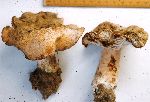
Owner: B.P. Segedin | 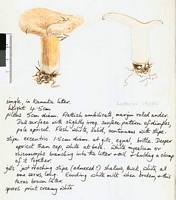
Caption: Watercolour
Owner: G.M. Taylor | 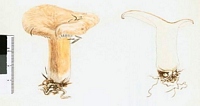
Owner: G.M. Taylor | 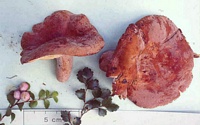
Owner: Karl Soop | 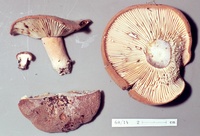
Caption: ZT68-014
Owner: E. Horak: © Creative Commons Attribution-Noncommercial 3.0 New Zealand | 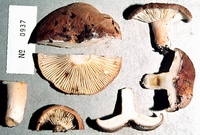
Caption: ZT0937
Owner: E. Horak: © Creative Commons Attribution-Noncommercial 3.0 New Zealand |
Article: McNabb, R.F.R. (1971). The Russulaceae of New Zealand. 1. Lactarius DC ex S.F. Gray. New Zealand Journal of Botany 9(1): 46-66 (http://www.rsnz.org/publish/abstracts.php).
Description: pileus:5-8 cm diam., convex when young, plano-convex or centrally depressed at maturity, dry, coarsely tomentose or villose, azonate, hairs often matted, occasionally aggregated into poorly defined squamules, pallid orange to greyish orange, with pallid greyish overtones imparted by the tomentose surface; margins involute to strongly involute at maturity, entire or occasionally lobed, thick. Cuticle composed of erect, thick-walled, yellow tinted, smooth, sparingly septate, filamentous elements to 400 µm long, 3-6 µm diam., simple or basally branched, apices rounded or bluntly acuminate, originating from a well-defined layer of sphaerocysts 6-10 cells thick. lamellae: adnate to sub-decurrent, subdistant, thick, simple or occasionally forked near stipe, to 5 mm deep, creamy white to pallid cream, often heavily discoloured with brownish spots where latex has dried; lamellulae present in 2-3 unequal series; latex viscid, white, unchanging on immediate exposure to air, drying brown. stipe: 2-3-(5) cm long, sub equal or tapering basally, 1.5-2 cm diam., solid or slightly hollowed at maturity, dry, velutinate to tomentose, greyish orange to apricot apically, paling to greyish orange or pallid orange basally, extreme base white or tinted orange: flesh white, firm, unchanging. Cuticle similar to that of pileus, but filamentous elements not arising from a cellular layer; ends of lactiferous hyphae occasionally intermixed with hairs. spores: spore print white; spores broadly elliptical, obliquely apiculate, apiculus to 1.5µm long, 8-10.5 X 6-8.5 µm, ornamentation of amyloid verrucae to 0.6 µm high, isolated, or a few adjacent verrucae joined by fine amyloid ridges; plage indistinct. hymenium: basidia hyaline, subclavate to clavate, 55-85 X 7-12.5 µm, 4-spored, sterigmata to 8 µm-long; pleurocystidia scattered, sparse to numerous, cylindrical, subclavate, or strangulate, hyaline, thin-walled, not or only slightly projecting beyond basidia, 65-130 X 4-7 µm; cheilocystidia numerous, subcylindrical, cylindrical, or subclavate, often undulate apically, hyaline, thin-walled, 42-75 X 3.5-5.5 µm; pseudocystidia sparse, scattered, originating from lactiferous hyphae, irregularly cylindrical, to 7µm diam. hymenophoral trama: heteromerous, composed of lactiferous hyphae, connective hyphae, and numerous sphaerocysts in both proximal and distal halves of lamellae; subhymenium of short-celled hyphae, appearing cellular in section, context of pileus: white, unchanging, firm. taste: lamellae and context mild. chemical characters: formalin - n.r.; phenol - slowly deep vinaceous; FeSO4 - rapidly greyish green; KOH on pileus - darkening; on context - yellowing; NH4OH on pileus - darkening slightly; on context - n.r.
Habitat: so litary or occasionally gregarious under Leptospermum
|